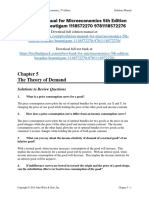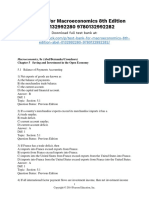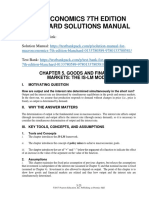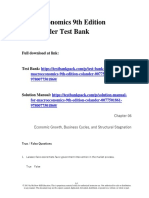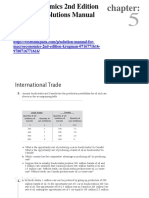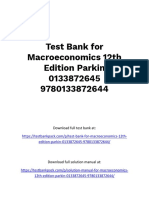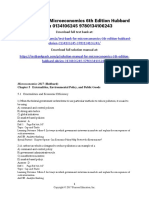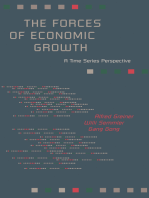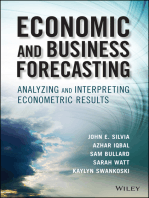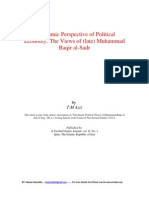Macroeconomics 9th Edition Abel Solutions Manual 1
Macroeconomics 9th Edition Abel Solutions Manual 1
Uploaded by
roseCopyright:
Available Formats
Macroeconomics 9th Edition Abel Solutions Manual 1
Macroeconomics 9th Edition Abel Solutions Manual 1
Uploaded by
roseOriginal Description:
Copyright
Available Formats
Share this document
Did you find this document useful?
Is this content inappropriate?
Copyright:
Available Formats
Macroeconomics 9th Edition Abel Solutions Manual 1
Macroeconomics 9th Edition Abel Solutions Manual 1
Uploaded by
roseCopyright:
Available Formats
Macroeconomics 9th Edition
Abel Solutions Manual
Full download at link:
Solution Manual: https://testbankpack.com/p/solution-manual-for-
macroeconomics-9th-edition-abel-bernanke-croushore-0134167392-
9780134167398/
Test Bank: https://testbankpack.com/p/test-bank-for-macroeconomics-
9th-edition-abel-bernanke-croushore-0134167392-9780134167398/
Chapter 6
Long-Run Economic Growth
◼ Learning Objectives
©2017 Pearson Education, Inc.
122 Abel/Bernanke/Croushore • Macroeconomics, Ninth Edition
I. Goals of Chapter 6
A. Discuss the sources of economic growth and the fundamentals of growth accounting (Sec. 6.1)
B. Explain the factors affecting long-run living standards in the Solow model (Sec. 6.2)
C. Summarize endogenous growth theory (Sec. 6.3)
D. Discuss government policies for raising long-run living standards (Sec. 6.4)
II. Notes to Eighth Edition Users
A. We shortened and simplified the discussion of the post-1973 slowdown in productivity growth
B. We renamed the application on “The Recent Surge in U.S. Productivity Growth” to “The
Rebound in U.S. Productivity Growth,” with modified data
©2017 Pearson Education, Inc.
Chapter 6 Long-Run Economic Growth 123
◼ Teaching Notes
I. The Sources of Economic Growth (Sec. 6.1)
A. Production function
Y = AF(K, N) (6.1)
1. Decompose into growth rate form: the growth accounting equation
Y/Y = A/A + aK K/K + aN N/N (6.2)
2. The a terms are the elasticities of output with respect to the inputs (capital and labor)
3. Interpretation
a. A rise of 10% in A raises output by 10%
b. A rise of 10% in K raises output by aK times 10%
c. A rise of 10% in N raises output by aN times 10%
4. Both aK and aN are less than 1 due to diminishing marginal productivity
B. Growth accounting
1. Four steps in breaking output growth into its causes (productivity growth, capital input
growth, labor input growth)
a. Get data on Y/Y, K/K, and N/N, adjusting for quality changes
b. Estimate aK and aN from historical data
c. Calculate the contributions of K and N as aK K/K and aN N/N, respectively
d. Calculate productivity growth as the residual: A/A = Y/Y – aK K/K – aN N/N
Numerical Problems 1 and 2 are growth accounting exercises.
2. Growth accounting and productivity trends
a. Denison’s results for 1929–1982 (text Table 6.3)
(1) Entire period output growth 2.92%; due to labor 1.34%; due to capital 0.56%; due to
productivity 1.02%
(2) Pre-1948 capital growth was much slower than post-1948
(3) Post-1973 labor growth slightly slower than pre-1973
(4) Productivity growth is major difference
(a) Entire period: 1.02%
(b) 1929–1948: 1.01%
(c) 1948–1973: 1.53%
(d) 1973–1982: –0.27%
b. Productivity growth slowdown occurred in all major developed countries
Theoretical Application
Growth accounting provides the basis for the real business cycle (RBC) model of the economy,
which we will discuss in greater detail in Chapter 10. The RBC model takes movements in total
factor productivity to be the primary source of business cycle fluctuations.
3. Application: the post-1973 slowdown in productivity growth
What caused the decline in productivity?
a. The legal and human environment—regulations for pollution control and worker safety,
crime, and declines in educational quality
©2017 Pearson Education, Inc.
124 Abel/Bernanke/Croushore • Macroeconomics, Ninth Edition
Data Application
Mark Wynne’s article, “The Comparative Growth Performance of the U.S. Economy in the
Postwar Period,” Federal Reserve Bank of Dallas Economic Review, First Quarter 1992,
pp. 1–16, argues that the postwar period up to the mid-1970s showed extraordinary productivity
growth. After the mid-1970s, productivity returned to more normal levels.
b. Oil prices—huge increase in oil prices reduced productivity of capital and labor,
especially in basic industries
c. New industrial revolution—learning process for information technology from 1973 to
1990 meant slower growth
4. Application: the rebound in U.S. productivity growth
a. Labor productivity growth increased sharply in the second half of the 1990s
b. Labor productivity and TFP grew steadily from 1982 to 2008 (text Fig. 6.1)
c. Labor productivity growth has generally exceeded TFP growth since 1995 (Fig. 6.2)
d. The gap between labor productivity growth and TFP growth can be seen in the equation
Y N A K N
− = + aK − (6.3)
Y N A K N
(1) Equation (6.3) suggests that labor productivity growth (the left-side term) exceeds
TFP growth (the first right-side term) when capital growth exceeds labor growth
e. The increase in labor productivity can be traced to the ICT (information and
communications technologies) revolution
(1) But other countries also had an ICT revolution, and their labor productivity did not
rise as much as in the United States
(2) European labor productivity did not rise as much as in the United States because of
government regulations
f. Why is there such a lag between ICT investment and increases in productivity?
(1) Because productivity improvements require not just technological advances, but also
investment in intangible capital—research and development, reorganization of firms,
and worker training
g. Is the recent episode unique in U.S. history?
(1) Not really: 1873–1890—steam power, trains, telegraph; 1917–1927—electrification
in factories; 1948–1973—transistor
II. Long-Run Growth: The Solow Model (Sec. 6.2)
A. Two basic questions about growth
1. What’s the relationship between the long-run standard of living and the saving rate,
population growth rate, and rate of technical progress?
2. How does economic growth change over time? Will it speed up, slow down, or stabilize?
B. Setup of the Solow model
1. Basic assumptions and variables
a. Population and workforce grow at same rate n
b. Economy is closed and G = 0
c. Ct = Yt − It (6.4)
d. Rewrite everything in per-worker terms: yt = Yt/Nt; ct = Ct/Nt; kt = Kt/Nt
e. kt is also called the capital-labor ratio
2. The per-worker production function
a. yt = f(kt) (6.5)
©2017 Pearson Education, Inc.
Chapter 6 Long-Run Economic Growth 125
b. Assume no productivity growth for now (add it later)
c. Plot of per-worker production function—text Figure 6.3
d. Same shape as aggregate production function
Numerical Problem 3 and Analytical Problem 6 work with the per-worker production function.
3. Steady states
a. Steady state: yt, ct, and kt are constant over time
b. Gross investment must
(1) Replace worn out capital, dKt
(2) Expand so the capital stock grows as the economy grows, nKt
c. It = (n + d)Kt (6.6)
d. From Eq. (6.4),
Ct = Yt − It = Yt − (n + d)Kt (6.7)
e. In per-worker terms, in steady state
c = f(k) − (n + d)k (6.8)
f. Plot of c, f(k), and (n + d)k (Figure 6.1; identical to text Figure 6.4)
g. Increasing k will increase c up to a point
(1) This is kG in the figure, the Golden Rule capital-labor ratio
(2) For k beyond this point, c will decline
(3) But we assume henceforth that k is less than kG, so c always rises as k rises
©2017 Pearson Education, Inc.
126 Abel/Bernanke/Croushore • Macroeconomics, Ninth Edition
Figure 6.1
4. Reaching the steady state
a. Suppose saving is proportional to current income:
St = sYt, (6.9)
where s is the saving rate, which is between 0 and 1
b. Equating saving to investment gives
sYt = (n + d)Kt (6.10)
c. Putting this in per-worker terms gives
sf(k) = (n + d)k (6.11)
d. Plot of sf(k) and (n + d)k (Figure 6.2; identical to text Figure 6.5)
©2017 Pearson Education, Inc.
Chapter 6 Long-Run Economic Growth 127
Figure 6.2
e. The only possible steady-state capital-labor ratio is k*
f. Output at that point is y* = f(k*); consumption is c* = f(k*) − (n + d)k*
g. If k begins at some level other than k*, it will move toward k*
(1) For k below k*, saving > the amount of investment needed to keep k constant,
so k rises
(2) For k above k*, saving < the amount of investment needed to keep k constant,
so k falls
Numerical Problems 5, 6, and 7 look at equilibrium in the Solow model.
h. To summarize, with no productivity growth, the economy reaches a steady state, with
constant capital-labor ratio, output per worker, and consumption per worker
C. The fundamental determinants of long-run living standards
1. The saving rate
a. Higher saving rate means higher capital-labor ratio, higher output per worker, and higher
consumption per worker (shown in text Figure 6.6)
b. Should a policy goal be to raise the saving rate?
(1) Not necessarily, since the cost is lower consumption in the short run
(2) There is a trade-off between present and future consumption
2. Population growth
a. Higher population growth means a lower capital-labor ratio, lower output per worker,
and lower consumption per worker (shown in text Figure 6.7)
b. Should a policy goal be to reduce population growth?
(1) Doing so will raise consumption per worker
(2) But it will reduce total output and consumption, affecting a nation’s ability to defend
itself or influence world events
c. The Solow model also assumes that the proportion of the population of working age is
fixed
(1) But when population growth changes dramatically this may not be true
(2) Changes in cohort sizes may cause problems for social security systems and areas
like health care
©2017 Pearson Education, Inc.
128 Abel/Bernanke/Croushore • Macroeconomics, Ninth Edition
3. Productivity growth
a. The key factor in economic growth is productivity improvement
b. Productivity improvement raises output per worker for a given level of the capital-labor
ratio (text Fig. 6.8)
c. In equilibrium, productivity improvement increases the capital-labor ratio, output per
worker, and consumption per worker
(1) Productivity improvement directly improves the amount that can be produced at
any capital-labor ratio
(2) The increase in output per worker increases the supply of saving, causing the
long-run capital-labor ratio to rise
d. Can consumption per worker grow indefinitely?
(1) The saving rate can’t rise forever (it peaks at 100%) and the population growth rate
can’t fall forever
(2) But productivity and innovation can always occur, so living standards can rise
continuously
e. Summary: The rate of productivity improvement is the dominant factor determining how
quickly living standards rise
Analytical Problems 1, 2, 3, and 4 look at how changes in the fundamentals affect an economy’s
economic growth.
4. Application: The growth of China
a. China is an economic juggernaut
(1) Population 1.4 billion people
(2) Real GDP per capita is low but growing (Table 6.4)
(3) Starting with low level of GDP, but growing rapidly (Fig. 6.10)
b. Fast output growth attributable to
(1) Huge increase in capital investment
(2) Fast productivity growth (in part from changing to a market economy)
(3) Increased trade
c. Will China be able to keep growing rapidly?
(1) Rapid growth because of use of underemployed resources, using advanced
technology developed elsewhere, and making the transition from a centrally-planned
economy to a market economy
(2) Such gains may not last
d. So, it may take China a long time to catch up with the rest of the developed world
III. Endogenous Growth Theory—Explaining the Sources of Productivity Growth (Sec. 6.3)
A. Aggregate production function
Y = AK (6.12)
1. Constant MPK
a. Human capital
(1) Knowledge, skills, and training of individuals
(2) Human capital tends to increase in same proportion as physical capital
©2017 Pearson Education, Inc.
Chapter 6 Long-Run Economic Growth 129
Data Application
For more information and a look at the data on the returns to human capital, see Ellis W. Tallman
and Ping Wang, “Human Capital Investment and Economic Growth: New Routes in Theory
Address Old Questions,” Federal Reserve Bank of Atlanta Economic Review, September/October
1992, pp. 1–12. For an excellent and more detailed overview of endogenous growth theory, see
the symposium in the Journal of Economic Perspectives, Winter 1994.
b. Research and development programs
c. Increases in capital and output generate increased technical knowledge, which offsets
decline in MPK from having more capital
B. Implications of endogenous growth
1. Suppose saving is a constant fraction of output: S = sAK
2. Since investment = net investment + depreciation, I = K + dK
3. Setting investment equal to saving implies:
K + dK = sAK (6.13)
4. Rearrange (6.13):
K/K = sA − d (6.14)
5. Since output is proportional to capital, Y/Y = K/K, so
Y/Y = sA − d (6.15)
6. Thus the saving rate affects the long-run growth rate (not true in Solow model)
Theoretical Application
The Wall Street Journal discussed the theory of endogenous growth and the contributions of
Stanford economist Paul Romer, in the article “Wealth of Notions,” January 21, 1997.
C. Summary
1. Endogenous growth theory attempts to explain, rather than assume, the economy’s growth
rate
2. The growth rate depends on many things, such as the saving rate, that can be affected by
government policies
Policy Application
For a good review of how government policy can contribute to economic growth, see Satyajit
Chatterjee, “Making More Out of Less: The Recipe for Long-Term Economic Growth,” Federal
Reserve Bank of Philadelphia Business Review, May/June 1994.
©2017 Pearson Education, Inc.
130 Abel/Bernanke/Croushore • Macroeconomics, Ninth Edition
Data Application
Is the Solow model or the model of endogenous growth a better representation of how economic
growth is determined? To find out, Ben S. Bernanke and Refet S. Gürkaynak of Princeton
University examined data from many different countries from 1960 to 1998 (“Is Growth
Exogenous? Taking Mankiw, Romer, and Weil Seriously,” NBER Macroeconomics Annual 2001,
in Ben S. Bernanke and Kenneth Rogoff, eds., Cambridge, MA: MIT Press, 2002). They tested
whether the Solow model or several alternative models of endogenous growth were more
consistent with the data.
Bernanke and Gürkaynak tested a key implication of the Solow model: that the steady-state
growth rate of a country does not depend on variables such as the rate of human capital
accumulation and the saving rate. They found that, in fact, countries’ growth rates are closely
correlated with both the saving rate and the rate of human capital accumulation, which suggests
either that the Solow model does not work well or that the economies are not in steady state.
However, the Solow model implies that even if an economy is not in a steady state, the growth
rate of total factor productivity (TFP) is exogenous: it does not depend on the saving rate or on
any other behavioral variable, such as the level of education in a country or the growth rate of the
labor force. After constructing measures of long-run TFP growth for about 50 countries,
Bernanke and Gürkaynak examined the relationship between it and other variables. They found
that there is, in fact, a strong relationship between TFP growth and the saving rate, some
relationship between TFP growth and the growth rate of the labor force, and a weaker
relationship between TFP growth and the level of education. Thus, the data do not support the
Solow model.
Models of endogenous growth imply that human capital formation and physical capital
accumulation should be related to the long-run growth rate of output. Bernanke and Gürkaynak
found that there is indeed such a relationship in the data across many countries. However, the
models they test are not perfect, as they cannot explain why savings rates and rates of human
capital accumulation differ so much across countries.
Overall, the research of Bernanke and Gürkaynak suggests that models of endogenous growth
hold more promise than the Solow model in explaining economic growth.
IV. Government Policies to Raise Long-Run Living Standards (Sec. 6.4)
A. Policies to affect the saving rate
1. If the private market is efficient, the government shouldn’t try to change the saving rate
a. The private market’s saving rate represents its trade-off of present for future consumption
b. But if tax laws or myopia cause an inefficiently low level of saving, government policy to
raise the saving rate may be justified
2. How can saving be increased?
a. One way is to raise the real interest rate to encourage saving; but the response of saving to
changes in the real interest rate seems to be small
b. Another way is to increase government saving
(1) The government could reduce the deficit or run a surplus
(2) But under Ricardian equivalence, tax increases to reduce the deficit won’t affect
national saving
B. Policies to raise the rate of productivity growth
1. Improving infrastructure
a. Infrastructure: highways, bridges, utilities, dams, and airports
b. Empirical studies suggest a link between infrastructure and productivity
©2017 Pearson Education, Inc.
Chapter 6 Long-Run Economic Growth 131
c. U.S. infrastructure spending has declined in the last two decades
d. Would increased infrastructure spending increase productivity?
(1) There might be reverse causation: Richer countries with higher productivity spend
more on infrastructure, rather than vice versa
(2) Infrastructure investments by government may be inefficient, since politics, not
economic efficiency, is often the main determinant
2. Building human capital
a. There’s a strong connection between productivity and human capital
b. Government can encourage human capital formation through educational policies,
worker training and relocation programs, and health programs
c. Another form of human capital is entrepreneurial skill
Government could help by removing barriers like red tape
3. Encouraging research and development
a. Support scientific research
b. Fund government research facilities
c. Provide grants to researchers
d. Contract for particular projects
e. Give tax incentives
f. Provide support for science education
Policy Application
Many issues relating to government policy and its effects on growth are discussed in a special issue
of the Journal of Monetary Economics, December 1993. The articles were presented at a World
Bank Conference on the research project, “How Do National Policies Affect Long-Run Growth?”
©2017 Pearson Education, Inc.
132 Abel/Bernanke/Croushore • Macroeconomics, Ninth Edition
◼ Additional Issues for Classroom Discussion
1. More on Measurement and Productivity
The textbook discusses some of the issues involved in measurement and productivity. If the quality of
outputs isn’t accounted for accurately, then increases in quality go unmeasured, and real GDP is higher
than is measured. But the implications go even further. To see this, discuss the issue of computers used
as capital with your class.
When computers are part of a firm’s capital, they contribute to production. Suppose, however, that the
government counts more computers than there really are. This could happen, for example, if it was using a
computer price that was several years old in constructing its price index. In this case, how does measured
productivity differ from actual productivity? This is relevant, since, despite the increased use of
computers, total factor productivity has barely budged over the past 20 years.
2. Financial Institutions and Growth
We often take for granted our well-developed financial system. But many countries have financial
institutions that are much more primitive than ours. You may wish to discuss with your class the
relationship between financial institutions and growth.
You could begin by asking how small, medium, and large companies in the United States obtain financing
for investment. Your students will note that smaller companies more likely rely on banks or internally
generated funds, while larger companies can borrow directly in the stock and bond markets. Then you can
discuss how individuals borrow to buy houses and other durable goods. Again, there are a variety of
financial sources. Next, ask them to think about whether such financial institutions are likely to be
available in either war torn countries or newly industrializing countries. Finally, you might point out that
even advanced countries like Japan have suffered in recent years from failing to have strong financial
institutions in place.
3. Is Growth Good?
Students like to discuss the benefits versus the costs of growth. While it’s easy for the government to
calculate output (GDP), it’s much harder to account for the quality of life. And everyone is aware of the
trade-offs between growth and quality of life, as seen in such side effects of growth as pollution, traffic,
and suburban sprawl.
Ask your students whether they think our economy’s current growth rate is about right, or should it be
slower to prevent some of the problems growth causes? Should we allow strip mines to rip giant holes in
the earth, just to provide coal and minerals at lower prices? Should we allow the production of radioactive
waste, just to have cheaper electricity? Should we allow species to become extinct, just to allow new
housing developments? Should we destroy the rainforests, just to reduce the cost of doing business in
South America?
©2017 Pearson Education, Inc.
Chapter 6 Long-Run Economic Growth 133
◼ Answers to Textbook Problems
Review Questions
1. The three sources of economic growth are capital growth, labor growth, and productivity growth. The
growth accounting approach is derived from the production function.
2. A decline in productivity growth is the primary reason for the slowdown in output growth in the
United States since 1973. Productivity growth may have declined because of deterioration in the legal
and human environment, reduced rates of technological innovation, and the effects of high oil prices.
To some extent the apparent decline in productivity may be due to measurement difficulties.
3. The rise in productivity growth in the 1990s occurred because of the revolution in information and
communications technologies (ICT). Not only were there improvements in ICT, but also government
regulations did not rein in the growth of productivity in the United States, as they did in other
countries, such as those in Europe. In addition, intangible investment (research and development,
reorganization of firms, and worker training) allowed the ICT improvements to boost productivity.
4. A steady state is a situation in which the economy’s output per worker, consumption per worker,
and capital stock per worker are constant.
5. If there is no productivity growth, then output per worker, consumption per worker, and capital per
worker will all be constant in the long run. This represents a steady state for the economy.
6. The statement is false. Increases in the capital-labor ratio increase consumption per worker in the
steady state only up to a point. If the capital-labor ratio is too high, then consumption per worker may
decline due to diminishing marginal returns to capital, and the need to divert much of output to
maintaining the capital-labor ratio.
7. (a) An increase in the saving rate increases long-run living standards, as higher saving allows for
more investment and a larger capital stock.
(b) An increase in the population growth rate reduces long-run living standards, as more output must
be used to equip the larger number of new workers with capital, leaving less output available to
increase consumption or capital per worker.
(c) A one-time increase in productivity increases living standards directly, by increasing output, and
indirectly, since by raising incomes it also raises saving and the capital stock.
8. Endogenous growth theory suggests that the main sources of productivity growth are accumulation
of human capital (the knowledge, skills, and training of individuals) and technological innovation
(research and development, as well as learning by doing). The production function in an endogenous
growth model does not exhibit diminishing marginal productivity of capital. This differs from the
production function in the Solow model, which has diminishing marginal productivity of capital.
9. Government policies to promote economic growth include policies to raise the saving rate and
policies to increase productivity. One way to increase the saving rate is to increase the real return
to saving by providing a tax break, as Individual Retirement Accounts did in the United States.
Unfortunately, the response of saving to increases in the real rate of return is small. Another way to
increase the saving rate is to reduce the government budget deficit. However, the theory of Ricardian
equivalence suggests that this will not do much to increase national saving. Note that an increase in
the saving rate will increase the steady-state capital-labor ratio, but will not increase the long-run rate
of economic growth.
©2017 Pearson Education, Inc.
134 Abel/Bernanke/Croushore • Macroeconomics, Ninth Edition
One way that government policy can increase productivity is by spending more on the economy’s
infrastructure, which has been neglected over the past two decades in the United States. Another
possibility is to support the creation of human capital by spending more on education and training
programs, and reducing barriers to entrepreneurial activity. The issue is whether the government
should intervene in the market to do these things, or whether the free market by itself provides an
efficient outcome.
A one-time increase in productivity will increase the steady-state capital-labor ratio but will not
increase the long-run rate of economic growth. To increase the long-run rate of economic growth,
the growth rate of productivity must be permanently increased.
Endogenous growth theory modifies these conclusions to some extent. A rise in the saving rate leads
to a higher long-run rate of economic growth in endogenous growth models.
©2017 Pearson Education, Inc.
Chapter 6 Long-Run Economic Growth 135
Numerical Problems
1. Hare: $5000 (1.03)70 = $39,589
Tortoise: $5000 (1.01)70 = $10,034
2.
20 Years Ago Today Percent Change
Y 1000 1300 30%
K 2500 3250 30%
N 500 575 15%
(a) A/A = Y/Y − aK K/K − aN N/N
= 30% − (0.3 30%) − 0.7 15%
= 30% − 9% − 10.5%
= 10.5%
Capital growth contributed 9% (aK K/K), labor growth contributed 10.5% (aN N/N),
productivity growth was 10.5%.
(b) A/A = 30% − (0.5 30%) − (0.5 15%)
= 30% − 15% − 7.5%
= 7.5%
Capital growth contributed 15% (aK K/K), labor growth contributed 7.5% (aN N/N),
productivity growth was 7.5%.
3. (a)
Year K N Y K/N Y/N
1 200 1000 617 0.20 0.617
2 250 1000 660 0.25 0.660
3 250 1250 771 0.20 0.617
4 300 1200 792 0.25 0.660
This production function can be written in per-worker form since Y/N = K.3N.7/N = K.3/N.3 =
(K/N).3. Note that K/N is the same in years 1 and 3, and so is Y/N. Also, K/N is the same in years
2 and 4, and so is Y/N.
(b)
Year K N Y K/N Y/N
1 200 1000 1231 0.20 1.231
2 250 1000 1316 0.25 1.316
3 250 1250 1574 0.20 1.259
4 300 1200 1609 0.25 1.341
©2017 Pearson Education, Inc.
136 Abel/Bernanke/Croushore • Macroeconomics, Ninth Edition
This production function can’t be written in per-worker form since Y/N = K.3N.8/N = K.3/N.2. Note
that K/N is the same in years 1 and 3, but Y/N is not the same in these years. The same is true for
years 2 and 4.
4. To answer this problem, an approximate solution can be found by finding the ratio GDP (2010)/GDP
(1950), taking the natural logarithm of that ratio and dividing by 60. This is the answer given in the
table below.
Real GDP Per Capita Growth
1950 2010 Ratio Rate
Australia 7,412 25,301 3.41 2.1%
Canada 7,291 25,267 3.47 2.1%
France 5,186 22,223 4.29 2.5%
Germany 3,881 20,801 5.36 2.9%
Japan 1,921 22,816 11.88 4.3%
Sweden 6,769 24,409 3.61 2.2%
United Kingdom 6,939 23,742 3.42 2.1%
United States 9,561 31,178 3.26 2.0%
Germany and Japan had the highest growth rates because damage from World War II caused capital
per worker to be lower than its steady-state level, and thus output per worker was temporarily low.
5. (a) sf(k) = (n + d)k
0.3 3k.5 = (0.05 + 0.1)k
0.9k.5 = 0.15k
0.9/0.15 = k/k.5
6 = k.5
k = 62 = 36
y = 3k.5 = 3 6 = 18
c = y − (n + d)k = 18 − (0.15 36) = 12.6
(b) sf(k) = (n + d)k
0.4 3k.5 = (0.05 + 0.1)k
1.2k.5 = 0.15k
1.2/0.15 = k/k.5
8 = k.5
k = 82 = 64
y = 3k.5 = 3 8 = 24
c = y − (n + d)k = 24 − (0.15 64) = 14.4
(c) sf(k) = (n + d)k
0.3 3k.5 = (0.08 + 0.1)k
0.9k.5 = 0.18k
0.9/0.18 = k/k.5
5 = k.5
©2017 Pearson Education, Inc.
Chapter 6 Long-Run Economic Growth 137
k = 52 = 25
y = 3k.5 = 3 5 = 15
c = y – (n + d)k = 15 − (0.18 25) = 10.5
(d) sf(k) = (n + d)k
0.3 4k.5 = (0.05 + 0.1)k
1.2k.5 = 0.15k
1.2/0.15 = k/k.5
8 = k.5
k = 82 = 64
y = 4k.5 = 4 8 = 32
c = y – (n + d)k = 32 − (0.15 64) = 22.4
6. (a) In steady state, sf(k) = (n + d)k
0.1 6k.5 = (0.01 + 0.14)k
0.6k.5 = 0.15k
0.6/0.15 = k/k.5
4 = k.5
k = 42 = 16 = capital per worker
y = 6k.5 = 6 4 = 24 = output per worker
c = .9 y = .9 24 = 21.6 = consumption per worker
(n + d)k = 0.15 16 = 2.4 = investment per worker
(b) To get y = 2 24 = 48, since y = 6k.5, then 48 = 6k.5, so k.5 = 8, so k = 64. The capital-labor ratio
would need to increase from 16 to 64. To get k = 64, since sf(k) = (n + d)k, s 48 = 0.15 64, so
s = 0.2. Saving per worker would need to double.
7. First, derive saving per worker as sy = y − c − g = [1 − 0.5(1 − t) − t] 8k.5 = 0.5(1 − t)8k.5 = 4 (1 − t)k.5
(a) When t = 0, sy = 4 (1 − 0)k.5 = 4k.5 = national saving per worker
Investment per worker = (n + d)k = 0.1k
In steady state, sy = (n + d)k, so 4k.5 = 0.1k, or 40k.5 = k, so 1600k = k2, so k = 1600. Since k = 1600,
y = 8 1600.5 = 320, c = 0.5(1 − 0)320 = 160, and (n + d)k = 0.1 1600 = 160 = investment
per worker.
(b) When t = 0.5, sy = 4 (1 − 0.5)k.5 = 2k.5 = national saving per worker
Investment per worker = (n + d)k = .1k
In steady state, sy = (n + d)k, so 2k.5 = 0.1k, or 20k.5 = k, so 400k = k2, so k = 400. Since k = 400,
y = 8 400.5 = 160, c = 0.5(1 − 0.5)160 = 40, and (n + d)k = 0.1 400 = 40 = investment per
worker, g = ty = 0.5 160 = 80.
©2017 Pearson Education, Inc.
138 Abel/Bernanke/Croushore • Macroeconomics, Ninth Edition
Analytical Problems
1. (a) The destruction of some of a country’s capital stock in a war would have no effect on the steady
state, because there has been no change in s, f, n, or d. Instead, k is reduced temporarily, but
equilibrium forces eventually drive k to the same steady-state value as before.
(b) Immigration raises n from n1 to n2 in Figure 6.3. The rise in n lowers steady-state k, leading to a
lower steady-state consumption per worker.
Figure 6.3
(c) The rise in energy prices reduces the productivity of capital per worker. This causes sf(k) to shift
down from sf 1(k) to sf 2(k) in Figure 6.4. The result is a decline in steady-state k. Steady-state
consumption per worker falls for two reasons: (1) Each unit of capital has a lower productivity,
and (2) steady-state k is reduced.
Figure 6.4
(d) A temporary rise in s has no effect on the steady-state equilibrium.
(e) The increase in the size of the labor force does not affect the growth rate of the labor force, so
there is no impact on the steady-state capital-labor ratio or on consumption per worker. However,
because a larger fraction of the population is working, consumption per person increases.
2. (a) Solow model
©2017 Pearson Education, Inc.
Chapter 6 Long-Run Economic Growth 139
The rise in capital depreciation shifts up the (n + d)k line from (n + d1)k to (n + d2)k, as shown in
Figure 6.5. The equilibrium steady-state capital-labor ratio declines. With a lower capital-labor
ratio, output per worker is lower, so consumption per worker is lower (using the assumption that
the capital-labor ratio is not so high that an increase in k will reduce consumption per worker).
There is no effect on the long-run growth rate of the total capital stock, because in the long run
the capital stock must grow at the same rate (n) as the labor force grows, so that the capital-labor
ratio is constant.
Figure 6.5
(b) Endogenous growth model
In an endogenous growth model, the growth rate of output is Y/Y = sA − d, so the rise in the
depreciation rate reduces the economy’s growth rate. Similarly, the growth rate of capital equals
K/K = sA − d, which also declines when the depreciation rate rises. Since consumption is a
constant fraction of output, its growth rate declines as well. So the increase in the depreciation
rate reduces the long-run growth rate of the capital stock, as well as long-run capital, output, and
consumption per worker.
3. (a) With a balanced budget T/N = g. National saving is S = s(Y – T) = sN[(Y/N) − (T/N)] =
sN( y – g). Setting saving equal to investment gives
S = I,
sN(y – g) = (n + d)K,
s(y – g) = (n + d)k,
s[f(k) – g] = (n + d)k.
*
This equilibrium point k is shown in Figure 6.6.
©2017 Pearson Education, Inc.
140 Abel/Bernanke/Croushore • Macroeconomics, Ninth Edition
Figure 6.6
(b) If the government permanently increases purchases per worker, the s[ f(k) – g] curve shifts down
from s[ f(k) – g1] to s[ f(k) – g2] in Figure 6.7. In steady-state equilibrium, the capital-labor ratio
is lower. Output per worker, capital per worker, and consumption per worker are lower in the
steady state. The optimal level of government purchases is not zero—it depends on the benefits
of the government purchases as well as on the costs of these purchases.
Figure 6.7
4. St = sYt – hKt = Nt(syt – hkt). Setting St = It yields Nt(syt – hkt) = (n + d)Kt. Dividing through by Nt and
eliminating time subscripts for steady-state variables gives sy – hk = (n + d)k. Rearranging and using
the expression y = f(k) gives sf(k) = (n + d + h)k.
The steady-state value of capital per worker, k*, is given by the intersection of the (n + d + h)k line
with the sf(k) curve, as shown in Figure 6.8. Output per worker is f(k*). Since Ct = Yt – St, c = y –
(sy – hk) = (1 – s)f(k*) + hk*. This expression gives consumption per worker.
©2017 Pearson Education, Inc.
Chapter 6 Long-Run Economic Growth 141
Figure 6.8
A change in the steady-state value of h increases the slope of the (n + d + h)k line, as shown in
Figure 6.9. This reduces the steady-state value of per-worker capital (k*), per-worker output
[since y* = f(k*)], and per-worker consumption [since c* = (1 − s)y* + hk* and both y* and k* decline].
Figure 6.9
5. The initial level of the capital-labor ratio is irrelevant for the steady state. Two economies that are
identical except for their initial capital-labor ratios will have exactly the same steady state.
Since the two economies must have the same growth rate at the steady state, and since the economy
with the higher current capital-labor ratio has higher current output per worker, then the country with
the lower current capital-labor ratio must grow faster.
The answer holds true regardless of which country is in a steady state. If the country with a higher
initial capital-labor ratio is in a steady state at capital-labor ratio k*, then the other country’s capital-
labor ratio will rise until it too equals k*. So the country with the lower capital-labor ratio grows
faster than the one with the higher capital-labor ratio.
If the country with the lower initial capital-labor ratio is in a steady state at capital-labor ratio k*, then
the other country’s capital-labor ratio is too high and it will decline until it equals k*. So the country
with the higher capital-labor ratio must grow more slowly than the country with the lower capital-
©2017 Pearson Education, Inc.
142 Abel/Bernanke/Croushore • Macroeconomics, Ninth Edition
labor ratio. If the two countries are allowed to trade with each other, then their convergence to the
same capital-labor ratio and output per worker will occur even faster.
6. The growth accounting equation is
Y/Y = A/A + (aK K/K) + (aN N/N).
We are just increasing the amount of capital and labor, and there is no change in productivity, so
A/A = 0. If the production function can be written in per-worker terms, then total output must
increase in the same proportion as the percentage increase in capital and labor, so K/K = N/N =
Y/Y = X. Plugging this into the growth accounting equation,
Y/Y = A/A + (aK K/K) + (aN N/N),
X = 0 + aKX + aNX,
X = (aK + aN)X,
aK + aN = 1.
7. Assume there are a constant number of workers, N, so that Ny = Y and Nk = K. Since y = Akah1–a and
h = Bk, then y = Ak a(Bk)1–a = (AB1–a)k. Then Y = Ny = (AB1–a)K = XK, where X equals AB1–a. This puts
the production function in notation used in the chapter.
Investment is K + dK = sY = national saving. Dividing through both sides of that expression by K
and using the production function gives K/K + d = sXK/K = sX, so K/K = sX − d, which is the long-
run growth rate of physical capital. Since output and human capital are proportional to physical
capital, they will all grow at that same rate.
Working with Macroeconomic Data
1. a. After 1973, productivity contributes less to GDP growth than before 1973. Productivity’s
contribution declines sharply in the 1970s and early 1980s.
b. Large spikes upward in oil prices are associated with large downward spikes in the contribution of
productivity to GDP growth, suggesting that oil shocks contribute substantially to declines in
GDP.
2. There is little evidence of a steady state being reached in the capital-labor ratio, though it is fairly
constant from 2010 to 2014. The continued growth in the output-labor ratio and the consumption-
labor ratio comes from growth in the capital-labor ratio and productivity growth.
3. Results here will depend on the countries picked and the time period chosen. There is some evidence
that countries that start with low real output per capita grow faster than countries that start with
higher output per capita (China, for example), but it is not the case for all countries.
©2017 Pearson Education, Inc.
You might also like
- Microeconomics 5th Edition Besanko Solutions Manual 1Document31 pagesMicroeconomics 5th Edition Besanko Solutions Manual 1scott100% (62)
- Macroeconomics 8th Edition Abel Test Bank 1Document35 pagesMacroeconomics 8th Edition Abel Test Bank 1rose99% (72)
- Macroeconomics 9th Edition Abel Bernanke Croushore 0134167392 9780134167398 Solution ManualDocument36 pagesMacroeconomics 9th Edition Abel Bernanke Croushore 0134167392 9780134167398 Solution Manualmichaelwhiteixkomfjedz100% (42)
- Macroeconomics Canada in The Global Environment Canadian 9th Edition Parkin Solutions Manual 1Document22 pagesMacroeconomics Canada in The Global Environment Canadian 9th Edition Parkin Solutions Manual 1richard100% (69)
- Macroeconomics 7th Edition Blanchard Solutions Manual 1Document5 pagesMacroeconomics 7th Edition Blanchard Solutions Manual 1rose100% (61)
- Raz-Plus For 6-9 PDFDocument1 pageRaz-Plus For 6-9 PDFQueenthunk AmalanathanNo ratings yet
- Macroeconomics 9th Edition Abel Test Bank 1Document38 pagesMacroeconomics 9th Edition Abel Test Bank 1paula100% (60)
- Macroeconomics 9th Edition Boyes Test Bank 1Document22 pagesMacroeconomics 9th Edition Boyes Test Bank 1paula100% (65)
- Macroeconomics 9th Edition Colander Solutions Manual 1Document20 pagesMacroeconomics 9th Edition Colander Solutions Manual 1paula100% (69)
- Macroeconomics 9th Edition Colander Test Bank 1Document102 pagesMacroeconomics 9th Edition Colander Test Bank 1paula100% (61)
- Macroeconomics 6th Edition Hubbard Test Bank 1Document76 pagesMacroeconomics 6th Edition Hubbard Test Bank 1mattie100% (63)
- Macroeconomics 9th Edition Mankiw Test Bank 1Document27 pagesMacroeconomics 9th Edition Mankiw Test Bank 1paula100% (67)
- Macroeconomics 2nd Edition Hubbard Test Bank 1Document1,532 pagesMacroeconomics 2nd Edition Hubbard Test Bank 1christopher100% (59)
- Macroeconomics A Contemporary Approach 10th Edition McEachern Test Bank 1Document33 pagesMacroeconomics A Contemporary Approach 10th Edition McEachern Test Bank 1paula100% (59)
- Macroeconomics 4th Edition Krugman Solutions Manual 1Document14 pagesMacroeconomics 4th Edition Krugman Solutions Manual 1lise100% (69)
- Macroeconomics A Contemporary Approach 10th Edition McEachern Solutions Manual 1Document8 pagesMacroeconomics A Contemporary Approach 10th Edition McEachern Solutions Manual 1paula100% (71)
- Macroeconomics 6th Edition Blanchard Solutions Manual 1Document6 pagesMacroeconomics 6th Edition Blanchard Solutions Manual 1shirley100% (64)
- Macroeconomics 6th Edition Hall Test Bank 1Document24 pagesMacroeconomics 6th Edition Hall Test Bank 1mattie100% (68)
- Macroeconomics 5th Edition Williamson Test Bank 1Document15 pagesMacroeconomics 5th Edition Williamson Test Bank 1shirley100% (67)
- Macroeconomics 6th Edition Hall Solutions Manual 1Document10 pagesMacroeconomics 6th Edition Hall Solutions Manual 1mattie100% (67)
- Macroeconomics Canadian 5th Edition Blanchard Test Bank 1Document14 pagesMacroeconomics Canadian 5th Edition Blanchard Test Bank 1jason100% (66)
- Macroeconomics Canadian 5th Edition Mankiw Solutions Manual 1Document22 pagesMacroeconomics Canadian 5th Edition Mankiw Solutions Manual 1jason100% (76)
- Macroeconomics 4th Edition Hubbard Test Bank 1Document43 pagesMacroeconomics 4th Edition Hubbard Test Bank 1lise100% (60)
- Macroeconomics 4th Edition Krugman 1464110379 9781464110375 Test BankDocument36 pagesMacroeconomics 4th Edition Krugman 1464110379 9781464110375 Test Bankmichaelwhiteixkomfjedz100% (43)
- Macroeconomics Canadian 1st Edition Karlan Test Bank 1Document63 pagesMacroeconomics Canadian 1st Edition Karlan Test Bank 1terry100% (73)
- Macroeconomics Canadian 5th Edition Blanchard Solutions Manual 1Document4 pagesMacroeconomics Canadian 5th Edition Blanchard Solutions Manual 1terry100% (70)
- Microeconomics 5th Edition Besanko Test Bank 1Document25 pagesMicroeconomics 5th Edition Besanko Test Bank 1christina100% (70)
- Macroeconomics Canadian 7th Edition Abel Test Bank 1Document20 pagesMacroeconomics Canadian 7th Edition Abel Test Bank 1jason100% (65)
- Macroeconomics Canadian 2nd Edition Hubbard Test Bank 1Document98 pagesMacroeconomics Canadian 2nd Edition Hubbard Test Bank 1terry100% (65)
- Macroeconomics Canadian 14th Edition Mcconnell Test Bank 1Document2 pagesMacroeconomics Canadian 14th Edition Mcconnell Test Bank 1amy100% (65)
- Microeconomics 6th Edition Hubbard Solutions Manual 1Document27 pagesMicroeconomics 6th Edition Hubbard Solutions Manual 1christina100% (66)
- Macroeconomics 2nd Edition Krugman Solutions Manual 1Document13 pagesMacroeconomics 2nd Edition Krugman Solutions Manual 1louis100% (65)
- Macroeconomics 4th Edition Krugman 1464110379 9781464110375 Solution ManualDocument25 pagesMacroeconomics 4th Edition Krugman 1464110379 9781464110375 Solution Manualmichaelwhiteixkomfjedz100% (37)
- Macroeconomics 11th Edition Slavin Test Bank 1Document307 pagesMacroeconomics 11th Edition Slavin Test Bank 1ka100% (62)
- Macroeconomics 10th Edition Colander Solutions Manual 1Document11 pagesMacroeconomics 10th Edition Colander Solutions Manual 1bertha100% (70)
- Macroeconomics Canadian 15th Edition Ragan Test Bank 1Document50 pagesMacroeconomics Canadian 15th Edition Ragan Test Bank 1amy100% (69)
- Macroeconomics 12th Edition Michael Parkin Test Bank 1Document115 pagesMacroeconomics 12th Edition Michael Parkin Test Bank 1ka100% (66)
- Macroeconomics Theories and Policies 10th Edition Froyen Test Bank 1Document36 pagesMacroeconomics Theories and Policies 10th Edition Froyen Test Bank 1tylerphillipsfxwqamkpei100% (36)
- Macroeconomics 2nd Edition Karlan Solutions Manual 1Document15 pagesMacroeconomics 2nd Edition Karlan Solutions Manual 1louis100% (69)
- Macroeconomics For Today 8th Edition Tucker Test Bank 1Document36 pagesMacroeconomics For Today 8th Edition Tucker Test Bank 1charlessalasnekqjrfzyx100% (46)
- Macroeconomics Theories and Policies 10th Edition Froyen Solutions Manual 1Document36 pagesMacroeconomics Theories and Policies 10th Edition Froyen Solutions Manual 1tylerphillipsfxwqamkpei100% (46)
- Macroeconomics 12th Edition Michael Parkin Solutions Manual 1Document14 pagesMacroeconomics 12th Edition Michael Parkin Solutions Manual 1ka100% (58)
- Macroeconomics 11th Edition Michael Parkin Test Bank 1Document124 pagesMacroeconomics 11th Edition Michael Parkin Test Bank 1bertha100% (66)
- Macroeconomics Canadian 8th Edition Sayre Solutions Manual 1Document9 pagesMacroeconomics Canadian 8th Edition Sayre Solutions Manual 1tyrone100% (73)
- Macroeconomics Canadian 8th Edition Sayre Test Bank 1Document36 pagesMacroeconomics Canadian 8th Edition Sayre Test Bank 1marychaveznpfesgkmwx98% (50)
- Microeconomics 1st Edition Acemoglu Test Bank 1Document36 pagesMicroeconomics 1st Edition Acemoglu Test Bank 1josephcaseybzoqrfksgm100% (36)
- Macroeconomics For Today 8th Edition Tucker Test Bank 1Document38 pagesMacroeconomics For Today 8th Edition Tucker Test Bank 1tyrone100% (57)
- Macroeconomics 20th Edition McConnell Solutions Manual 1Document21 pagesMacroeconomics 20th Edition McConnell Solutions Manual 1ka100% (63)
- Macroeconomics Private and Public Choice 15th Edition Gwartney Test Bank 1Document36 pagesMacroeconomics Private and Public Choice 15th Edition Gwartney Test Bank 1tylerphillipsfxwqamkpei100% (42)
- International Financial Management 7th Edition Eun Solutions Manual DownloadDocument17 pagesInternational Financial Management 7th Edition Eun Solutions Manual DownloadDale Mcdowell100% (22)
- Microeconomics 6th Edition Hubbard Test Bank 1Document90 pagesMicroeconomics 6th Edition Hubbard Test Bank 1christina100% (69)
- Microeconomics Theory and Applications With Calculus 4th Edition Perloff Test Bank 1Document36 pagesMicroeconomics Theory and Applications With Calculus 4th Edition Perloff Test Bank 1shawnanderson05101996gqo100% (50)
- Macroeconomics Canadian 5th Edition Blanchard Solutions Manual 1Document35 pagesMacroeconomics Canadian 5th Edition Blanchard Solutions Manual 1marychaveznpfesgkmwx100% (45)
- Microeconomics Canadian 15th Edition Ragan Test Bank 1Document50 pagesMicroeconomics Canadian 15th Edition Ragan Test Bank 1michael100% (62)
- M Business 3rd Edition Ferrell Test Bank 1Document50 pagesM Business 3rd Edition Ferrell Test Bank 1james100% (66)
- Macroeconomics 9th Edition Abel Solutions Manual 1Document36 pagesMacroeconomics 9th Edition Abel Solutions Manual 1todddoughertygswzfbjaon100% (45)
- Macro Economics: A Simplified Detailed Edition for Students Understanding Fundamentals of MacroeconomicsFrom EverandMacro Economics: A Simplified Detailed Edition for Students Understanding Fundamentals of MacroeconomicsNo ratings yet
- Economic and Business Forecasting: Analyzing and Interpreting Econometric ResultsFrom EverandEconomic and Business Forecasting: Analyzing and Interpreting Econometric ResultsNo ratings yet
- Basic Income and Sovereign Money: The Alternative to Economic Crisis and Austerity PolicyFrom EverandBasic Income and Sovereign Money: The Alternative to Economic Crisis and Austerity PolicyNo ratings yet
- Signage - LandscapeDocument23 pagesSignage - LandscapeSatyam KumawatNo ratings yet
- Far1 Notes ReceivableDocument4 pagesFar1 Notes ReceivableRico Jay EmejasNo ratings yet
- GR - 237277 - 2019 Labor Case 61 PDFDocument15 pagesGR - 237277 - 2019 Labor Case 61 PDFTa JoseNo ratings yet
- Gonzales Cannon 9-22-11 IssueDocument32 pagesGonzales Cannon 9-22-11 IssueNikki MaxwellNo ratings yet
- An Islamic Perspective of Political Economy (ISLAMIC ECONOMIC SYSTEM) Ayatullah Baqar Ul SaddarDocument19 pagesAn Islamic Perspective of Political Economy (ISLAMIC ECONOMIC SYSTEM) Ayatullah Baqar Ul SaddarHassan100% (1)
- Bhagyanagar Plot Owners Welfare ... Vs State of Telangana On 4 June, 2019Document30 pagesBhagyanagar Plot Owners Welfare ... Vs State of Telangana On 4 June, 2019Shashank GinjupalliNo ratings yet
- DagaDocument29 pagesDagaDevRishi C. VijanNo ratings yet
- Diferencias As:like + Likely:Probably PDFDocument3 pagesDiferencias As:like + Likely:Probably PDFSashaNo ratings yet
- Complete Bidding Documents of Package-16 (1S1E) (PreQ) - (SW) - (07.11.2023)Document147 pagesComplete Bidding Documents of Package-16 (1S1E) (PreQ) - (SW) - (07.11.2023)TG CNo ratings yet
- International-Financial-Form - WfuDocument1 pageInternational-Financial-Form - WfuArjun SinghNo ratings yet
- The Settlement Performance of Stone Column Foundations: S C S VC VsDocument14 pagesThe Settlement Performance of Stone Column Foundations: S C S VC VsJuan Camilo PinedaNo ratings yet
- Revised Guidelines For Finance Companies in NigeriaDocument35 pagesRevised Guidelines For Finance Companies in NigeriaBright IkpangNo ratings yet
- 2017、2018、2019大学英语四级翻译真题及答案 - 百度文库Document12 pages2017、2018、2019大学英语四级翻译真题及答案 - 百度文库Huaiming HuNo ratings yet
- Arutha PanchakamDocument24 pagesArutha Panchakamajiva_rts100% (4)
- 2 - 3 E-Communications (CAT Grade 12)Document36 pages2 - 3 E-Communications (CAT Grade 12)KynG Beat[s] ZANo ratings yet
- Training Plan STD Inca 2017 ExxonDocument3 pagesTraining Plan STD Inca 2017 ExxonFajriNo ratings yet
- Tavor TAR-21 Assault Rifle - IsraelDocument5 pagesTavor TAR-21 Assault Rifle - IsraelRichard Harig100% (1)
- Imt 51Document4 pagesImt 51arun1974No ratings yet
- Beware 31012018 3Document5 pagesBeware 31012018 3nnadoziekenneth5No ratings yet
- Peta Okupasi Nasional Dalam Rangka Kualifikasi Nasional Indonesia Pada Area Fungsi Teknologi Informasi Dan Komunikasi Ver.03-301019Document1 pagePeta Okupasi Nasional Dalam Rangka Kualifikasi Nasional Indonesia Pada Area Fungsi Teknologi Informasi Dan Komunikasi Ver.03-301019abufaruqiNo ratings yet
- Shoppersstop ReportDocument44 pagesShoppersstop ReportAnkit GehlotNo ratings yet
- Election DataDocument12 pagesElection Datarileyjalon7No ratings yet
- TD RDF Rdfs+SolutionDocument6 pagesTD RDF Rdfs+Solutionlahoucine karkouchNo ratings yet
- Hindalco - Operation - Ditribution Channel of HindalcoDocument102 pagesHindalco - Operation - Ditribution Channel of Hindalcovibhav_vibhavtripathi80% (5)
- Management Strategies For Almarai Company (Order ID 275889)Document12 pagesManagement Strategies For Almarai Company (Order ID 275889)unveiledtopicsNo ratings yet
- Ann HathawayDocument14 pagesAnn Hathawaypierrette1100% (1)
- Employee Static InfoDocument10 pagesEmployee Static InfoLito Del Rosario VeluzNo ratings yet
- Empire of The Hajj - Pilgrims Plagues and Pan-Islam Under BritisDocument211 pagesEmpire of The Hajj - Pilgrims Plagues and Pan-Islam Under BritisOs EgehNo ratings yet
- CCAS SolarlistDocument9 pagesCCAS SolarlistSairaj ChaudhariNo ratings yet
